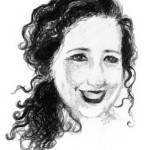In January, Lena Dunham, the star and creator of HBO’s hit series “Girls,” defended Vogue’s decision to publish altered images of her on their cover.
 In an interview, she said what I think many of us believe, despite public criticisms of magazines that photoshop the images on their covers: “A fashion magazine is like a beautiful fantasy. Vogue isn’t the place we go to look at realistic women … If [the people complaining] want to see what I really look like go watch the show I make every single week.” Dunham, also known for being proud of her “not tiny” thighs, gets naked frequently on episodes of “Girls.”
In an interview, she said what I think many of us believe, despite public criticisms of magazines that photoshop the images on their covers: “A fashion magazine is like a beautiful fantasy. Vogue isn’t the place we go to look at realistic women … If [the people complaining] want to see what I really look like go watch the show I make every single week.” Dunham, also known for being proud of her “not tiny” thighs, gets naked frequently on episodes of “Girls.”
Dunham’s argument struck me, precisely because I could imagine many of my Yale friends disagreeing with her argument. We are all accustomed to criticizing the fashion industry for promoting a dangerously impossible standard of beauty, and one which inspires women and girls across the country to negative body images. We’ve all seen before-and-after pictures of celebrities made to look thinner and more gaunt, to look as though they have perfect skin and bright eyes. How could Dunham justify something so wrong as misrepresentations of beauty?
But sometimes I think we misunderstand beauty. We misunderstand the fashion photography industry and the fantasies it works to create. Art is not meant to be realistic. Beauty is not supposed to merely portray truth. So ultimately I agree with Dunham’s defense of fashion photography. In fact, I thought it was pretty rude of Jezebel to offer $10,000 in exchange for the pre-processed photos, as if Dunham had no right to be presented, with her consent, any way other than the way she is.
What did bother me about Dunham’s cover image, upon consideration, is the way that the fashion world has begun to muddle the categories of celebrity and model, leading us into a world where all women must be able to double as models.
The practice of featuring photos of celebrities on magazine covers is fairly recent. Up until the 1990s, fashion magazines almost exclusively used models on their covers. Everyone else was featured inside. Fashion photography was about creating some whimsical scene, evoking a dramatic mood–basically, standard artistic practice. The switch to celebrities is often attributed to a 1989 decision by Anna Wintour, Vogue’s famed editor in chief, to use Madonna as a cover photo. Despite hesitations, sales of the Madonna-clad magazines spiked by 40%, and the industry — or so legend goes — was changed for good.
This shift from using models as cover girls to using celebrities is nearly complete. When was the last time you saw a magazine cover that featured a model, like the carefree and naturally styled Israeli girl Anna Wintour chose for her first cover at Vogue? Featuring celebrities, while perhaps raising sales, has merely widened the pool of those who need to look cover-ready.
To be a model is to enter a profession that is centered on beauty and physicality. Models are meant to be ogled. But celebrities are not. Female writers and actors — like Dunham — did not choose to enter the modeling profession. They are profiled and interviewed and photographed, but they’re not models, though they are treated as if they were when editors choose to put them on magazine covers. Today, fashion magazines are taking women of all lifestyles and professions, and turning them into models for their covers. This is unreasonable, both for the artistic integrity of fashion photography, and for the women who consume it.
There is a lot of talk on campus about being realistic about our own limitations. Invariably, this talk is also related to looks. We talk a lot about what it means to be visually presentable, to be physically acceptable. What it means to be beautiful. We should not expect our fashion and beauty magazines to provide us with realistic portrayals of the average woman. That is not their role.
Dunham was right when she said that people turn to Vogue for fantasy, and I don’t want to live in a world stripped of fantasy. Nonetheless, the wall between fantasy and reality needs to be made clearer. The crossover that currently exists is unfair for celebrities like Dunham and readers like ourselves.
Shira Telushkin is a senior in Pierson College. Her columns run on alternate Thursdays. Contact her at shira.telushkin@yale.edu .







